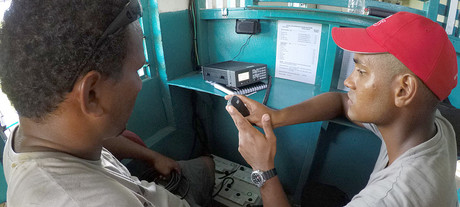Barrett radios assist Tuvalu, Dominica

An early warning and emergency HF system is keeping Tuvalu’s low-lying islands safe.
The government of Tuvalu has recently upgraded the country’s HF communications system as part of the National Adaptation Program of Action (NAPA). Tuvalu is no higher than three metres above sea level, making it susceptible to storm surges and natural disasters.
The early warning and emergency communications project was designed and implemented to improve the response to climate-related events by providing continuous communications with the outer islands. The communication systems are intended to be independent of existing public services and are required to be available at all times. A satellite-based alarm system and HF radio were proposed to accomplish this.
HF has been used in Tuvalu for many years; however, the infrastructure had deteriorated and became inoperable.
Following a competitive tender process, Barrett Communications was selected to supply the new equipment, which includes 2050 HF transceivers and 2020 email, data and fax systems. A combination of antennas were selected, as some islands had limited land for installation.
The entire system is powered by solar, with adequate reserve capacity to ensure reliable 24-hour operations to all sites.
On the main island of Funafuti, HF installations were provided at the Meteorological Office, Police Station, Telecom Exchange, NAPA Project Office and Fisheries Headquarters, as well as on the project’s water vessel.
Each outer island has an HF system installed at the Meteorological Office, or at the local Telecom Office when there is no Meteorological Office.

“HF radiocommunications is seeing a resurgence due to its reliability and its independence of infrastructure, making it perfect for early warning and emergency communications following natural or man-made disasters,” said Barrett Communications Managing Director Greg O’Neill.
“Systems similar to this are currently being used in other Pacific islands, islands of the Caribbean, in humanitarian aid activities in South America and in critical infrastructure projects in the United States of America.”
Caribbean comms
On the other side of the world, Barrett HF radio systems have been employed in relief work on the island of Dominica in the wake of Hurricane Maria.
First responders from St Vincent and the Grenadines travelled to Dominica to re-establish communications in the community of Wesley and to provide medical support to the community. The team of six included three medical staff, an emergency communications specialist and two radio operators.
The team travelled with two Barrett 2090 HF manpack transceivers and a Barrett tactical broadband antenna which was connected to existing HF ham transceivers. The HF network was established and used to coordinate the arrival of medical and food supplies, and to relay messages to other stations in Dominica where propagation was poor.
“We were able to quickly establish reliable communications both within Dominica and to other islands to support the recovery work,” Donald de Riggs, the emergency communications specialist, said.
“The tactical broadband antenna worked flawlessly, without a tuner, across the entire HF spectrum — a perfect match for any HF radio.”
The team also assisted the local FM radio station get back on the air to provide locals with information about the distribution of water and food, as well as general weather updates.
New technique to eliminate signals disrupting radio telescopes
An unexpected television signal traced to an aeroplane has led to a new method for pinpointing...
5G: the foundation for connected mobility
5G is the driving force behind safe and connected mobility, transforming the future of vehicles...
Hybrid connectivity for mining: keeping OT systems mobile and reliable
Hybrid connectivity solutions are emerging as the future of mining communications, ensuring that...





